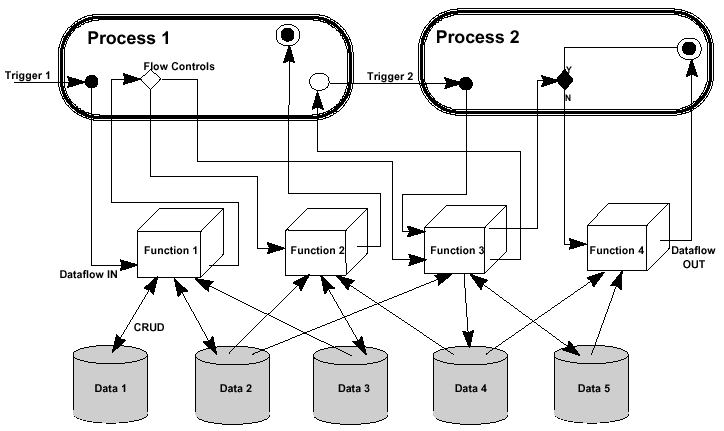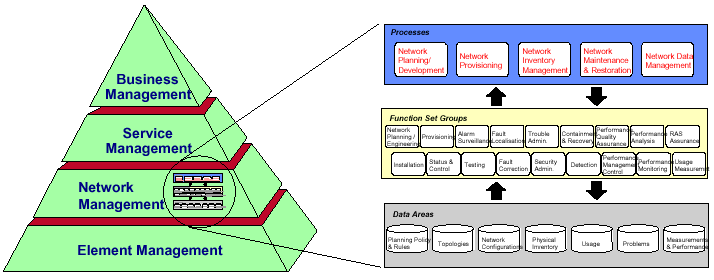|
TeleManagementForum
Network
Management Detailed Operations Map
(Конспект)
Глава 5. Процессы и функции управления сетью
Introduction In this section, Network Management processes are identified and each process is mapped onto its component functions. The modeling of the Network Management processes and functions is based on the following considerations: Ø Top-down decomposition of Service Management needs to guide the structuring of processes and to identify the supporting functions within Function Set Groups (as defined in ITU-T M.3400 - Ref. 3). Ø Positioning of the Network Management processes and functions within a layered management architecture, as described by the TMN Logical Layered Architecture (Ref. 4, ITU-T M.3010). Network Management processes, and the process flows that link these, have been derived from discussions and interviews with business planning and operational staff in a number of Service Providers. They represent a business-oriented (top-down) view of the structure of the Network Management Layer. The Function Set Groups are drawn from standards (see Reference 4) and reflect a structure and terminology which may also be familiar to operations and planning staff. Annex C provides a mapping between the defined processes and the Function Set Groups (and their underlying component Function Sets) relevant to the operation of each process. Annex D shows how the high level processes can be decomposed to sub-processes and provides a view on how processes and sub-processes relate to Function Set Groups and Function Sets. More information on the links with the TMN architecture is attached as Annex A. The relationship between processes and functions is illustrated in Figure 5.1 Рис. 5.1. Отношения между процессами, функциями и данными Key: CRUD = Create, Read, Update, Delete Processes describe the flow of activities to solve a particular business problem, or part of it. At early analysis stages for processes, the means of availability and how the data flows are not significant. Whether or not data is handed over or accessed in a central database is not addressed. However, processes are concerned with the triggers that set them into action. A function is a unit of processing (either initiated by humans or through an automated action) with specific, well-defined inputs and outputs. For functions (unlike processes) the data is essential because the function is described as a unit of processing together with its associated data inputs and outputs. As used in this framework, functions tend to be dedicated to a single purpose and highly granular. A process will typically make use of activities in a number of functions. Multiple processes may employ a given function. Thus, there is in principle a many-to-many mapping between process and function. Annex D shows examples of how the high level processes in this document might be decomposed into sub-processes, which may be linked together in ‘work strings’ (for instance by using workflow engines). It is recognized though that each NO or SP may perform this decomposition in a different way. Based on TMN standards (see Reference 4), functions with related or complementary capabilities are grouped into Function Set Groups, which then provide operational support to individual processes. It is envisioned that agreement is possible on the high-level processes and the standardized Function Set Groups, without constraining the way in which these are mapped through the intermediate work strings and sub-processes. This maintains the flexibility of application and implementation of this work in individual organizations, and provides harmonization of the underlying functional support and the broad process structure in which these are used. A function can be considered as a mechanistic reaction to specific inputs, and is thus relatively straightforward to automate. Whereas a process is a reaction to one or more triggers with the application of business rules, and can therefore be more complex to automate. By structuring processes, functions and data (see figure 5.1), their relationships can become clearer. This function-oriented perspective for understanding the content of processes supports the “top-down” analysis of processes, by identifying likely target functional capabilities which the processes will employ in carrying out their role. The overall analysis and design of individual process areas (using techniques such as UML for information models) will be handled within TM Forum by individual Working Groups, using the Telecom Operations Map as a common backdrop for their work. Methodology for Developing Business Methodology for Developing Business Processes Initially, an analysis of the business activities, functions and information flows is needed to guide the structuring of the overall operational environment into major processes, and to identify the contents and linkages between these. The following steps can be distinguished for the development of business processes:
Processes are distinguished within a management layer (such as Network Management) because they represent a major area of operational responsibility, and provide a clean separation of concerns between individual processes. In terms of TMN management layers, process flows occur vertically, from the Network Management Layer up to the Service, or down to Network Element Management Layers, as well as within the Network Management Layer itself. Indeed, the process flows to support the Service Management Layer are one of the primary drivers in this top-down approach to delivering business benefit. Another issue to recognize is that the dynamics of the lifecycle of each of these Layers is likely to be very different and the implications need to be well understood. A discussion of these issues can be found in Annex B. Overview of Processes, Functions and Data Areas An overview of Process, Function Set Group and Data Area names are presented here. The Processes, plus the Function Set Groups and Data they use, are described in more detail in below. (see also Reference 4 for the standardized definitions). The Function Set Groups and Data Areas are those identified as belonging to the Network Management Layer, but can be used by the processes within other layers, where this is appropriate. For example, Network Configuration functions may be used directly by the Service Configuration Process, for service configuration. These relationships are important for a complete view of the requirements placed on the functions. Figure 5.2 shows the high-level structure of Network Management processes, the supporting Function Set Groups, and the data areas on which these depend. The processes are those already identified in the lower layer of the earlier TMN Figure 4.2. Figure 5.3 positions Network Management operations within TMN. As an example, Network Provisioning might make use of a number of the Function Set Groups, such as Provisioning for the actual choice and set-up of network paths, and testing to validate that these are usable. Data concerning Topologies and Network Configurations may then be involved in supporting those functions (More detail is provided in subsequent diagrams). Key: RAS = Reliability, Availability and Survivability Figure 5.3: Positioning the Network Management Detailed Operations Figure 5.3: Positioning the Network Management Detailed Operations Map within TMN
|




